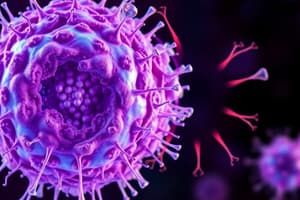Podcast
Questions and Answers
Which organelle is known as the 'powerhouse' of the cell?
Which organelle is known as the 'powerhouse' of the cell?
- Lysosome
- Golgi body
- Mitochondria (correct)
- Nucleus
The smooth endoplasmic reticulum contains ribosomes on its surface.
The smooth endoplasmic reticulum contains ribosomes on its surface.
False (B)
What is the primary function of ribosomes in a cell?
What is the primary function of ribosomes in a cell?
To synthesize proteins.
The ______________ is the semi-permeable membrane surrounding the cell.
The ______________ is the semi-permeable membrane surrounding the cell.
Match the following cell components with their functions:
Match the following cell components with their functions:
What role do lysosomes play in the cell?
What role do lysosomes play in the cell?
The cytoplasm is a jelly-like substance in which organelles are embedded.
The cytoplasm is a jelly-like substance in which organelles are embedded.
What is the primary function of the cell membrane?
What is the primary function of the cell membrane?
The ____________ is where ribosomes are formed.
The ____________ is where ribosomes are formed.
What are the two types of endoplasmic reticulum?
What are the two types of endoplasmic reticulum?
What is the primary function of the mitochondria in eukaryotic cells?
What is the primary function of the mitochondria in eukaryotic cells?
Eukaryotic cells lack a well-defined nucleus.
Eukaryotic cells lack a well-defined nucleus.
What is the role of the nucleus in eukaryotic cells?
What is the role of the nucleus in eukaryotic cells?
The __________ provides shape and support to plant cells.
The __________ provides shape and support to plant cells.
Match the following organelles with their functions:
Match the following organelles with their functions:
Which of the following types of endoplasmic reticulum is responsible for lipid synthesis?
Which of the following types of endoplasmic reticulum is responsible for lipid synthesis?
Vacuoles are only found in animal cells.
Vacuoles are only found in animal cells.
What are the primary differences in size between prokaryotic and eukaryotic cells?
What are the primary differences in size between prokaryotic and eukaryotic cells?
Cilia and flagella are categorized as __________ attachments.
Cilia and flagella are categorized as __________ attachments.
Which structure surrounds the cytoplasm and regulates the entry and exit of substances?
Which structure surrounds the cytoplasm and regulates the entry and exit of substances?
What is one key difference between prokaryotic and eukaryotic cells?
What is one key difference between prokaryotic and eukaryotic cells?
All living organisms share the ability to give birth to young ones.
All living organisms share the ability to give birth to young ones.
What is the location of the genetic material in prokaryotic cells called?
What is the location of the genetic material in prokaryotic cells called?
Eukaryotic cells are more _____ and contain various organelles.
Eukaryotic cells are more _____ and contain various organelles.
Match the following features with the type of cell:
Match the following features with the type of cell:
Flashcards are hidden until you start studying
Study Notes
Prokaryotic vs. Eukaryotic Cells
- Prokaryotes are small, simple cells; eukaryotic cells are large, complex, and can be unicellular or multicellular.
- Prokaryotic cells lack a well-defined nucleus; their DNA is located in a region called the nucleoid.
- Eukaryotic cells possess a well-defined nucleus that houses genetic material.
- Prokaryotic cells are considered primitive, while eukaryotic cells evolved from them.
- Eukaryotic cells have specialized organelles (e.g., endoplasmic reticulum, Golgi body, mitochondria) that perform distinct functions.
Life Processes of Living Cells
- Nutrition: Cells obtain food molecules for energy and metabolic functions.
- Digestion: Food is broken down into smaller units for cellular use, aided by enzymes.
- Absorption: Cells take in water, minerals, and other materials essential for life from their environment.
- Biosynthesis: Cells organize processes that produce ATP (Adenosine Triphosphate) for energy storage and transfer.
Principal Parts of a Cell
- Cell Membrane: Semi-permeable membrane regulating molecule movement in and out of cells. Known as the fluid mosaic model due to its dynamic nature.
- Cytoplasm: Jelly-like substance where organelles are suspended, facilitating their maintenance in place.
- Nucleus: Control center of the cell, containing DNA and the nucleolus, which forms ribosomes.
Endoplasmic Reticulum (ER)
- Structure: Series of tunnels in the cytoplasm, connecting nuclear and plasma membranes.
- Types:
- Smooth ER: No ribosomes; involved in lipid detoxification.
- Rough ER: Contains ribosomes; involved in protein synthesis and transport.
Other Cell Components
- Golgi Bodies: Package and distribute proteins received from the ER to various parts of the cell.
- Lysosomes: Contains hydrolytic enzymes that digest bacteria, food, and obsolete organelles.
- Mitochondria: Known as the "powerhouses" of the cell; produce ATP for energy.
- Cytoskeleton: Protein fibers providing structure and shape to the cell.
Characteristics of Eukaryotic Cells
- Eukaryotic means "true nucleus"; these cells feature a well-defined nucleus and specialized organelles.
- Major Components:
- Nucleus: Encloses chromosomes; involved in protein synthesis.
- Mitochondria: Generates ATP; contains its own DNA and ribosomes.
- Chloroplasts: Responsible for photosynthesis in plant and algae cells.
- Golgi Bodies: Involved in packaging and secreting materials.
- Vacuoles: Store nutrients and waste products; assist in material transport via endocytosis.
- Cell Wall: Provides structure and support; can consist of cellulose, chitin, or peptidoglycan.
Differences Between Prokaryotic and Eukaryotic Cells
- Size: Prokaryotic cells range from 0.5-3 µm; eukaryotic cells range from 2-100 µm.
- Cell Type: Prokaryotic cells are primitive and typically unicellular; eukaryotic cells are more advanced and often multicellular.
Studying That Suits You
Use AI to generate personalized quizzes and flashcards to suit your learning preferences.




